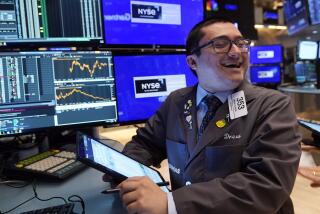Market Revival Is More Likely Than a Decline
Welcome to the stock market as media event. The late Marshall McLuhan, the Canadian scholar who predicted in the 1960s that advanced communications would turn the world into one big global village, would have been proud. The stock market on Monday confirmed his theory.
With investors in Tokyo and New York dancing to the same tunes and signals, the U.S. and Japanese stock markets fell into steep declines. But in some sense, as McLuhan used to say, the medium was the message--meaning activity got whipped up by events that, upon closer examination, look to be either of short-term significance or, frankly, media hype.
The truth is, nothing much is changing either economically or politically, but you wouldnât know that if you only watched the stock markets.
Consider the global trading day: Americans woke up Monday morning to reports that the dollar was falling to new low levels in relation to the Japanese yen and that share prices on the Tokyo stock exchange were suffering one of their worst declines ever.
Panic Set In
Then, as markets opened in New York, panic set in. In the first hour of trading the Dow Jones industrial average fell 78 points as Japanese and other foreign investors sold U.S. stocks and bonds. American investors got into the act, selling the stocks of smaller companies that trade on the American Stock Exchange and in the over-the-counter national market system, so that the down draft was total, hitting the stocks of companies large and small.
By the end of trading in New York, the Dow Jones average had fallen 57.39 points and the other, broader market indexes--the New York Stock Exchange composite, the American market value index and the OTC composite--showed serious declines also. Meanwhile, the dollar, which had declined to a postwar low in Tokyo, recovered only slightly in New York.
What frightened the markets? Several bogymen. The markets clearly were worried: that in order to stop the dollarâs decline--and keep Japanese investors buying our stocks, bonds and Treasury bills--the Federal Reserve would have to raise U.S. interest rates; that the Dow Jones average having declined a total of 4% in two sessions, the market would now continue on what Wall Street people call its long-awaited âcorrectionâ and decline an additional 200 points, and that a trade war was breaking out between the United States and Japan.
But the threat of trade war is more shadow than substance. It stems from political posturing by the U.S. and Japanese governments, both of which are staging media events designed to stave off protectionist trade legislation in the U.S. Congress. For example, the Reagan Administration with great fanfare last Friday threatened to impose 100% tariffs on $300 million worth of Japanese television sets, tape recorders and other products. That is, $300 million or one half of 1% of the $58-billion U.S. trade deficit with Japan. A political gesture, in other words, but not an act of war.
Welcome Political Gesture
Meanwhile, the Japanese Ministry of International Trade and Industry declared publicly over the weekend that Japanese government agencies would now buy supercomputers from Cray Research of Minneapolis. But that was no breakthrough. Several Japanese private companies--most recently Honda last November--have happily bought or leased Cray machines, without any fanfare. And for good reason: The Cray computers are the technological world leaders.
So it was no big deal in trade or commerce for the Japanese government to say it would buy Cray. But it was a welcome political gesture and, in any case, not at all a threat of trade war.
Similarly, there is more occasion for calm analysis and less for panic in the major reasons behind the marketâs decline on Monday. It was caused chiefly by Japanese investors selling U.S. securities because they were losing more on the dollarâs fall than they were earning in interest on U.S. bonds or dividends and appreciation on U.S. stocks.
But logically, that only indicates that a stable currency rate would get those investors buying again. And the Federal Reserve doesnât have to raise interest rates to achieve stability. Rather strong U.S. government actions to back up previous pledges of support for the dollar at a ratio of one buck to 150 yen could settle the currency. Long term, after all, the views of Japanese institutional investors--who are eager for U.S. investments and regard the dollar as likely to rise--have not changed.
Finally, says A. G. Edwards & Sons market analyst Alfred Goldman, Mondayâs decline was caused by U.S. investment managers selling stocks to record portfolio profits at the end of a quarter in which the Dow average has risen 476 points.
But their fundamental analysis, too, like that of their Japanese counterparts, is still predicting economic growth.
So the global market remains more likely to revive than decline.
More to Read
Inside the business of entertainment
The Wide Shot brings you news, analysis and insights on everything from streaming wars to production â and what it all means for the future.
You may occasionally receive promotional content from the Los Angeles Times.










